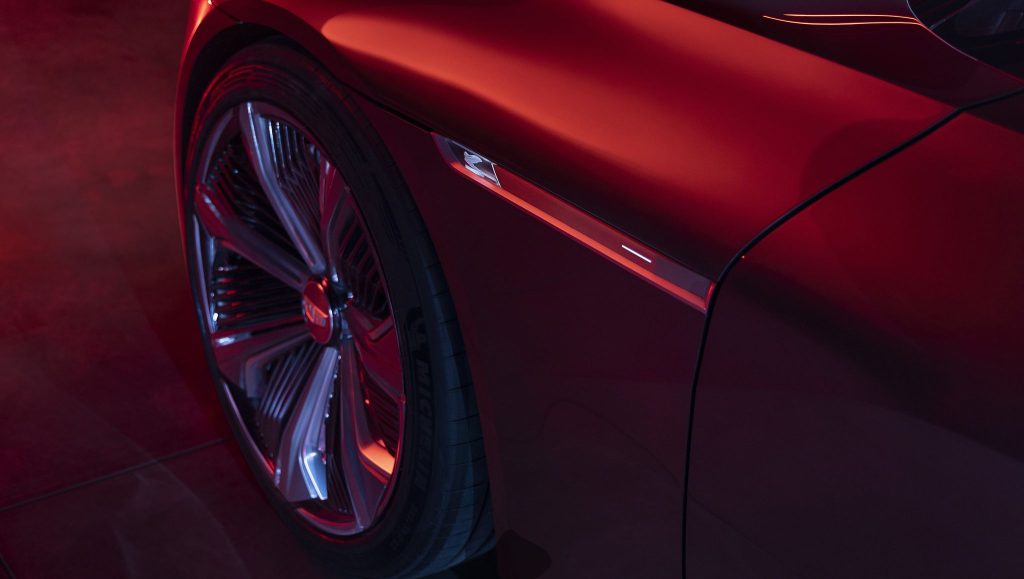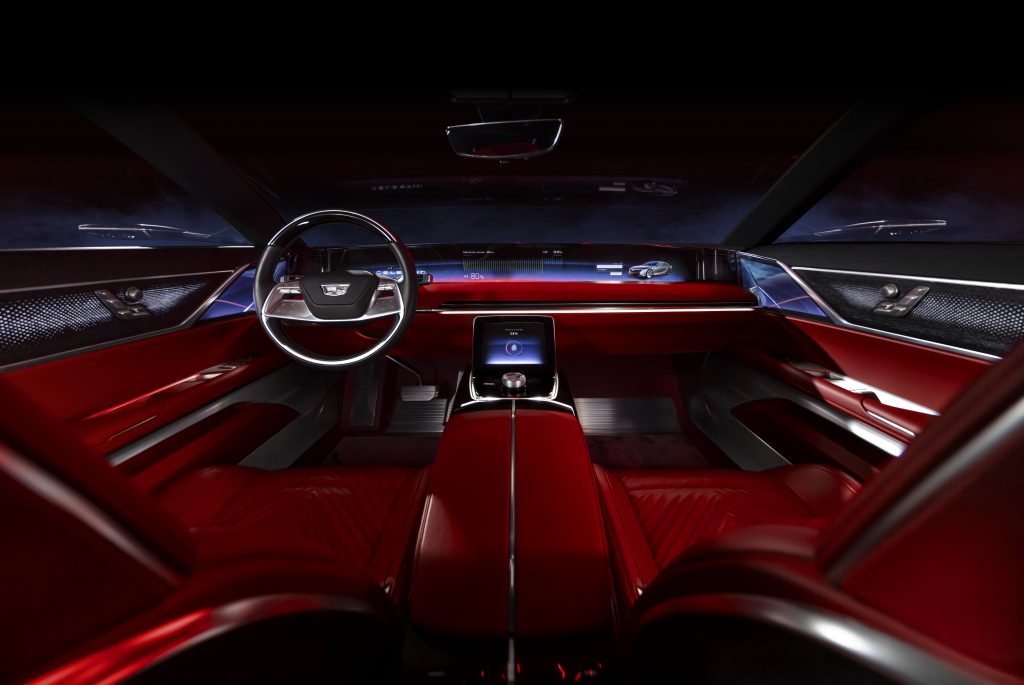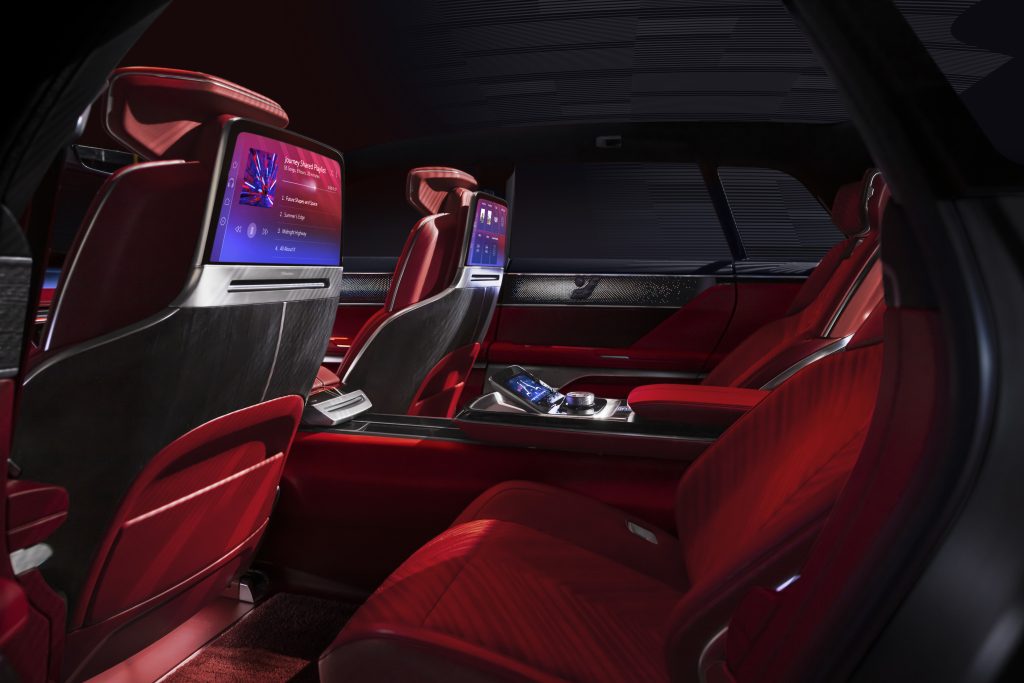Cadillac’s Highly Anticipated Luxury EV CELESTIQ Finally Unveiled
Bold proportions, innovative tech and handcrafted elements combine in this show-stopping sedan

Today, Cadillac unveils their CELESTIQ show car—a stunning luxury sedan that’s set to exist as the jewel of the Detroit-based carmaker’s electric vehicle lineup. Intended to be the embodiment of the brand, CELESTIQ combines futuristic tech and design with classic touches and pristine craftsmanship. We had the opportunity to see the car in Cadillac’s Design Center and see it firsthand.
Inside and out, the car draws inspiration from the craft and customization of early Cadillac sedans, architect Eero Saarinen‘s striking structures, musical instruments and more. While following the LYRIQ in terms of release date, the CELESTIQ (which will have a driving range of at least 300 miles) was in development before and will set the standard for many aspects of Cadillac’s future EVs. (In fact, it was inspired by the Escala concept car in 2016.)

Many of the elements in this hand-built car made it more difficult to bring from concept to reality but the team rarely compromised—every curve, shape, shade and texture has been considered and experimented with countless times. We met with various team members who agonized over these details—Erin Crossley (Design Director, Cadillac CELESTIQ), Magalie Debellis (Manager, Cadillac Advanced Design), Laetitia Lopez (Color and Trim creative designer), Tristan Murphy (Manager, Cadillac Interior Design) and Tony Roma (Chief Engineer, Cadillac CELESTIQ). While we often celebrate the creative team, it’s also important to acknowledge GM and Cadillac leadership here as well; it’s a bold move and a large investment. Most vehicles start the way we’d love to see them a lot gets lost in the business and cost analysis along the way. That’s not the case with CELESTIQ. It’s a testament to all the teams and how they are all invested in making it a brand icon.

“CELESTIQ really has been the guiding light for this paradigm shift in design for Cadillac as we transition to an EV brand. Even though we launched the LYRIQ first, this set the tone for everything,” Crossley tells us. “The amazing thing about this project is because there were so many things that we were trying to accomplish (relative to just keeping the likeness as similar as possible, to really having to dig in with our engineering partners on thinking about things in a different way and using non-traditional materials), we were allowed the time and space to actually do that, rather than rushing to a solution so that we could get it out there.”

The first thing people will notice about the CELESTIQ is its size and its spaceship curves. It’s large [it’s around the same length as the Cadillac Escalade] and feels elongated with its sweeping, sloping roof but it’s not massive or clunky. “It’s a very boldly proportioned car,” Crossley says. “It’s clean and simplistic, yet you can still see every tiny crease.”
Debellis adds, “We wanted to really rethink what will be the next icon for the brand, in parallel with the recommitment of the company to shift for a full electric portfolio. It was really ideal for us with the freedom of the new electric platform to come up with a proportion that’s very distinctive, very iconic, very unique.” The long dash to axle line only adds to the dramatic appearance. While the team didn’t want to create a car that was similar to anything else on the market, they did look to Cadillac’s own history—specifically the 1950s, when they looked at architecture. Additionally, there are contemporary haute couture fashion influences.
It’s a really nice balance between the technology and the human touch
From the grille’s theatrical lighting choreography to autonomous driving capability, radars and LIDARs (light detection and ranging), the vehicle is very future-forward. Despite all its new tech, the CELESTIQ will be entirely hand-built and hand-crafted at GM’s Saarinen-designed Global Technical Center, where the design studios are also located. It will be the first car built there since it opened in 1956. “It’s a really nice balance between the technology and the human touch,” Debellis says. “There is a lot of very innovative technology, but it’s important for us to express it in a very artful way.”

It was a challenge for the whole team to be able to house all that tech within the design they wanted. This meant plenty of collaboration between design and engineering. “The whole time, we stayed very connected,” Murphy says. “Especially when there were challenges.” During those challenges, the teams had to compromise, but all the sacred design elements remain as well as all the safety essentials. (“Roof crush keeps me awake at night,” Roma says.) There are several continuous straight lines inside the car that proved difficult to keep smooth and to maintain without there being a ripple effect of changes throughout the interior, but the result is impressive.

Inside, the vehicle is just as stunning. There’s a pillar-to-pillar screen that’s reconfigurable; the lefthand side mostly displays driver information, while the right can share that information or be used for entertainment. In the center console is another screen, which Murphy calls “the command center,” that controls everything from climate to the roof panel, doors and more. “Everything is really about emphasizing the length and the uninterrupted design,” Murphy continues. “It’s not only a way to show off the design, but also do something that we would never do in a high volume production car.”

The trunk of the car only adds to the spacious feel. Its open, airy design creates a roomy interior where backseat passengers will be just as comfortable as the driver. Not to be left out, it is fully kitted out in the same luxurious materials of your choice. The backseats also feature plenty of tech, each having their own large screens to control seats, windows and entertainment. The leather and fabrics are crafted using more sustainable manufacturing processes, with the leather sourced from a tannery that uses a dyeing process that involves only coffee beans. There’s much less leather waste, as well as a reduction in water use.

From the inside out, the CELESTIQ is spectacular, and will be customizable in countless ways—as one would imagine, considering the hefty price (rumored to be well north of $300,000 to start). There will be fewer than 500 vehicles built each year, each to the customer’s very personalized requirements. This is not a stop by the dealer and drive home in a new CELESTIQ journey. Each customer will work hands-on with a designer to customize their car, which will be built to order. As Murphy says, “we want the customer to get in and experience something that is really unlike anything else.”
Images courtesy of Cadillac












